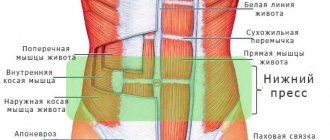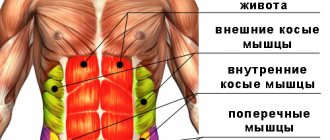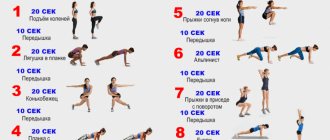Share:
We all know the main principle of achieving progress in sports. 40% training, 20% sleep, and 40% nutrition. But how to calculate nutrition correctly to achieve certain goals? Of course, a plan is drawn up for this, which takes into account physical and mental needs and expenses. But from this entire formula, one single factor drops out, which will be discussed in the next material - basal metabolism.
What it is
Basic metabolism is one of the indicators of the intensity of metabolism and energy in the human body. It is determined by the amount of fasting energy in optimal temperature conditions, which is necessary to maintain a state of complete physical and mental peace.
That is, basal metabolism shows how much energy the body spends to maintain the constant activity of internal organs and muscles.
The energy that the body receives as a result of such reactions is used to ensure a constant body temperature (source - Textbook “Physiology of Metabolism and the Endocrine System”, Tepperman).
Thanks to the completeness of basal metabolism, the following is ensured:
- Synthesis of basic hormones.
- Synthesis of basic enzymes.
- Providing basic cognitive function.
- Digestion of food.
- Dream.
- Maintaining immune function.
- Maintaining the ratio of anabolic to catabolic processes.
- Maintaining respiratory functions.
- Transportation of basic energy elements by blood.
- Maintaining a constant body temperature according to Rubner's law.
And this is not a complete list of what is happening in our body. In particular, even when a person sleeps, most of the processes, albeit in a slow manner, help synthesize new building elements and break down glycogen into glucose. All this requires a constant supply of calories, which a person gets from food. In particular, this basic consumption is the daily minimum norm of how many calories are needed to maintain basic body functions.
Metabolism: types and stages of metabolism.
Metabolism (“transformation, change”), metabolism is the complete process of transformation of chemical substances in the body, ensuring its growth, development, activity and life in general. In a living organism, energy is constantly consumed, not only during physical and mental work, but also during complete rest (sleep).
Metabolism is a complex of biochemical and energy processes that ensure the use of nutrients for the needs of the body and satisfy its needs for plastic and energy substances.
Metabolic stages
Conventionally, the metabolic process can be divided into three stages:
The first stage is the enzymatic breakdown of proteins, fats and carbohydrates into water-soluble amino acids, mono- and disaccharides, glycerol, fatty acids and other compounds, occurring in various parts of the gastrointestinal tract, and their absorption into the blood and lymph.
The second stage is the transport of nutrients from the blood to the tissues and cellular metabolism, which results in their enzymatic breakdown to final products. Some of these products are used to build the components of membranes, cytoplasm, for the synthesis of biologically active substances and the reproduction of cells and tissues. The breakdown of substances is accompanied by the release of energy, which is used for the process of synthesis and ensuring the functioning of each organ and the organism as a whole.
The third stage is the removal of metabolic end products in urine, feces, sweat, through the lungs in the form of CO2, etc.
Anabolism and catabolism
Metabolism consists of two opposite, simultaneously occurring processes.
The first - anabolism - combines all reactions associated with the synthesis of necessary substances, their absorption and use for the growth, development and functioning of the body.
The second - catabolism - includes reactions associated with the breakdown of substances, their oxidation and the removal of breakdown products from the body.
Mainly through the reactions of anabolism, the process of assimilation (absorption) of nutrients occurs, and the reactions of catabolism form the basis of dissimilation - the liberation of the body from the substances that constitute it (the use of the terms “assimilation” as a synonym for anabolism, and “dissimilation” as a synonym for catabolism is incorrect, since they are more general biological concepts).
Metabolism ensures the dynamic balance inherent in a living organism as a system, in which synthesis and destruction, reproduction and death are mutually balanced. Metabolic reactions are based on physical and chemical interactions between atoms and molecules, subject to the same laws for living and nonliving matter. What has been said means that the very possibility of the existence of life, in its fundamental essence, comes down to elementary acts of physical and chemical processes. But living organisms have their own characteristics.
Energy exchange in the body is inextricably linked with metabolism. Living organisms can exist only if there is a continuous supply of energy from outside. Therefore, they constantly need energy to perform various types of work: mechanical - moving the body, cardiac activity, etc.; galvanic - creating a potential difference in tissues and cells; chemical - synthesis of substances, etc.
The primary source of energy for all life on Earth, with very rare exceptions, is solar radiation. Food is formed thanks to the same energy of the Sun. The initial link of the food chain is plants that accumulate solar energy during photosynthesis. In the green pigment of plants - chlorophyll - under the influence of light quanta, organic substances - the basis of life - are synthesized from water and carbon dioxide.
The composition of food is complex and varied. It contains the most main nutrients, which include proteins, fats, and carbohydrates. Food also contains mineral elements - macroelements calcium, phosphorus, sodium, etc., microelements copper, cobalt, iodine, zinc, manganese, selenium, etc. There are also flavoring substances that give it special properties.
3. Formation, accumulation and consumption of energy that ensures the life of the body.
Energy in the body is generated continuously. All types of energy are converted into thermal energy. During the life of the body, energy is not only generated, but also continuously consumed. The ratio of energy entering the body to energy expended is called energy balance. Energy metabolism is the conversion of potential energy of nutrients into heat and work. The intensity of energy metabolism depends on the conditions in which the body is located. The body constantly has to expend the energy necessary to maintain the functioning of the brain, body temperature, activity of the heart, lungs and other organs, the work of which does not stop during life under any conditions. Energy consumption depends on the intensity of metabolic processes in the body, power, duration of work, as well as on gender, age, height, body weight, climatic and living conditions, nutrition, clothing. A person’s need for food (and therefore energy) changes significantly at different periods of life with changes in physiological functions and metabolism in the body.
The entire adult working population (from 18 to 60 years old), depending on the nature of work, is divided into 5 groups of types of labor activity (as the group increases, energy increases):
Group I – workers primarily in mental labor, approximately 2500 (very light physical activity);
II – people engaged in light labor approx. 2700 (light physical activity);
III – workers engaged in moderate labor of about 3000 (average physical activity);
IV – people engaged in heavy physical labor, approx. 3500 (high physical activity);
V – men engaged in particularly heavy physical labor, approx. 4000 (very high physical activity).
4. The body’s daily energy requirement, a method of approximate assessment.
Human energy is spent in three directions during the day:
1-basic metabolism (activity of internal organs at rest),
2- digestion of food,
3- different types of activities.
Human energy expenditure is usually expressed in units of calories (kcal) or J (kJ). The level of energy consumption varies depending on the nature of a person’s work, the state of the environment (in cold weather, energy consumption increases), the composition of food and the individual characteristics of a person (body weight, age, etc.).
According to the “Norms of physiological needs for nutrients and energy for various groups of the population” in force in Russia (developed by the Institute of Nutrition of the Russian Academy of Medical Sciences and approved by the Ministry of Health of the Russian Federation in 1991), the entire adult working population (from 18 to 60 years old) is divided depending on the nature of work into 5 groups of types of labor activity:
Group I – workers predominantly in mental work (very light physical activity);
II – people engaged in light work (light physical activity);
III – workers engaged in moderate labor (average physical activity);
IV – people engaged in heavy physical labor (high physical activity);
V – men engaged in particularly heavy physical labor (very high physical activity). Each group is divided into 3 categories: 18-29 years old, 30-39 years old, 40-59 years old. In addition, sexual differentiation is provided due to lower body weight and less intense metabolism in women compared to men.
There are the following approximate estimation methods:
1. Using a nomogram (height, weight - body surface), we calculate daily energy consumption using the formula.
2. Using the tabular method (by category depending on labor)
3. With the help of statistical studies, the daily requirement of the body is calculated for a certain profession.
Rubner surface
Oddly enough, sometimes metabolism is determined not only by biochemical processes, but also by simple physical laws.
Scientist Rubner discovered a relationship linking the total surface area with the number of calories expended.
How does it actually work? There are 2 main factors due to which his assumption turned out to be correct.
- 1st – the size of the organism. The larger the body surface, the larger the organs, and the greater the leverage in any action, which drives a larger “machine” that consumes “more fuel.”
- 2nd – keeping warm. For the normal functioning of the body, metabolic processes occur with the release of heat. In particular, for a person it is 36.6. Moreover, the temperature (with rare exceptions) is evenly distributed throughout the body. So, to heat a larger area, you need more energy. It all has to do with thermodynamics.
Therefore, from all this we can conclude:
Thick people actually spend more energy during their basal metabolic rate. Tall people are often thin due to a caloric deficit caused by an increased basal metabolism and spending on maintaining temperature over a larger body area.
How to determine basal metabolic rate
Basal metabolic rate is calculated using a special method called calorimetry. BOO is determined by a special camera that records metabolic processes in the body. Such a measurement is labor-intensive, so you can use an analogue that does calculations using gas exchange. To determine the elements subject to oxidation (fats, proteins, carbohydrates), the respiratory coefficient is calculated, which is the ratio of released carbon dioxide and absorbed oxygen. This coefficient has completely different meanings for the oxidation of carbohydrates, fats or proteins.
Rubner's surface rule
This law is that all energy expenditures of each warm-blooded individual are directly dependent on the surface of the body. That is, per square meter of body area the amount of heat is dissipated equally under standard conditions. Therefore, volume and mass have a direct effect on basal metabolic rate. In other words, the smaller you are, the fewer calories you need, and vice versa.
Rules for calculating basal metabolic rate
You can calculate your basal metabolic rate yourself. For this, several formulas are used that were invented more than a century ago. There are also many sites dedicated to a healthy lifestyle, which have an online calculator that allows you to quickly calculate the indicators of BOO suitable for normal life activities. To do this, you will need to enter the required values in the specified fields. But before that, use the formulas below and then compare the results.
Using total body weight, you can calculate your basal metabolic rate using the Harris-Benedict formula, the original version of which was invented back in 1919. In 1884, with adjustments for the modern way of life, it was significantly modified, so the result of the calculations will be more accurate.
Just plug in the numbers you need into the equations:
- How to calculate OO for men: P = (13.397 * weight, kg) + (4.799 * height, cm) – (5.677 * age) + 88.362;
- How to calculate basal metabolic rate for women: P = (9.247 * weight, kg) + (3.098 * height, cm) – (4.330 * age) + 447.593.
Where P is the heat produced by an organism at complete rest.
There is another basal metabolic rate formula based on total body weight - Mifflin-St. It is slightly more accurate than the previous one.
As an example, let's take a 55-year-old woman with a height of 168 cm and a weight of 59 kg. As a result, her BOO will be 1204 kcal.
But these equations have an inaccuracy - they do not include indicators of metabolic activity taking into account the amount of fat in the body. It turns out that if you choose two men with exactly the same height, weight and age, the results will be absolutely identical. In reality, their basal metabolic rate will be significantly different due to the fact that the first man is “fat” and the second is “jocked.”
For such cases, the Katch-McArd equation is used:
P = 370 + (21.6*LBM), where LBM is mass excluding fat. For example, with a weight of 70 kg, of which 30% is the fat component (it will be equal to 21 kg), the muscle component will be equal to 49 kg (70-21). When substituting this value into the formula, we get a result of 1428 kcal.
Thus, the basal metabolic rate can vary significantly among people with almost the same parameters. The indicators are also influenced by many other external and internal factors.
Calculator and table
If you are completely confused about calculating your basic metabolism, then to obtain more accurate and comprehensive information, it is better to contact a specialist who will tell you how many calories you need daily in order to be in an alert state and not gain extra pounds.
Each person’s body has individual characteristics, but there is a table of average values of basal metabolism that can be used by everyone. It indicates the minimum number of calories per day that a person requires, taking into account his basic parametric data.
Factors determining basal metabolism
The initial intensity of basal metabolism in men weighing about 70 kg is on average 1700 kcal. For women, these parameters are 10% less (source - Wikipedia).
If we consider the level of basal metabolism as a dynamic system, mobile, then there are factors that determine the basic background and the amount of energy distributed:
- Amount of incoming energy. The more frivolous a person is with his diet (constant excess of calories, frequent snacks, acceleration of metabolism), the more actively the body spends them even in passive mode. All this leads to constant hormonal levels and a general increase in the load on the body, and, as a result, faster failure of individual systems.
- The presence of artificial stimulants of metabolic rate. For example, people who drink caffeine have a lower basal metabolic rate when they quit caffeine. At the same time, their hormonal system begins to fail.
- General human mobility. So, during sleep, the body transports glucose from the liver to the muscles, synthesizes new amino acid chains, and synthesizes enzymes. The amount (and, therefore, resources) spent on these processes directly depends on the overall load on the body.
- Change in basal metabolic rate. If a person has brought himself out of balance (natural speed), then the body will spend additional energy on restoring and stabilizing all processes. Moreover, this applies to both acceleration and deceleration.
- Presence of external factors. A change in temperature will force the skin to intensively release heat to maintain the overall temperature, which can change the dynamic factor affecting the overall level of basal metabolism.
- The ratio of absorbed and excreted nutrients. With a constant excess of calories, the body can simply refuse extra nutrients, in this case, basal waste will increase due to the process of converting useful nutrients into transport slag.
In addition, it is worth highlighting the main end products of metabolism, which are excreted from the body regardless of its speed.
Metabolism regulation
Nervous regulation
In higher animals, metabolic processes are regulated by the nervous system, which influences the course of all chemical processes. All changes in the course of metabolism are perceived by the nervous system, which reflexively stimulates the formation and secretion of enzymatic systems that carry out the breakdown and synthesis of substances.
Humoral regulation
Metabolic processes also depend on humoral regulation, which is determined by the state of the endocrine glands. The endocrine organs, especially the pituitary gland, adrenal glands, thyroid and gonads, largely determine the course of metabolism. Some of them affect the intensity of the dissimilation process, while others affect the metabolism of individual substances, fats, minerals, carbohydrates, etc.
The role of the liver in metabolism
see Digestive glands#Liver functions
What is it regulated by?
Now we need to determine not only what the main energy is spent on during general metabolism, but also how the amount of energy expended is regulated.
- First, there is the initial metabolic rate, which is defined as the ratio of total mobility to the presence of excess energy.
- Secondly, basal metabolism is regulated by the initial level of hormones in the blood. For example, for diabetics or for people suffering from gastrointestinal problems, the overall metabolism will differ in speed and, accordingly, in costs from the average.
- Thirdly, age. As we get older, our basal metabolism slows down as we optimize our body's resources in an attempt to extend the lifespan of our core systems longer. This also includes height and initial body weight, since basal metabolism is dependent on these parameters.
- Plenty of oxygen. Without the oxidation of complex polysaccharides to the level of simple monosaccharides, the release of energy is impossible. More precisely, the mechanism of its isolation changes. With a large amount of oxygen, the rate of excretion increases, which also increases the cost of basic metabolism. At the same time, in conditions of lack of oxygen, the body can switch to burning fat tissue, which is radically different in speed and cost.
- Seasonality. It has been proven that in spring and early summer the basal metabolism is increased, and in winter and late autumn metabolic processes slow down.
- Nature of nutrition. Food and its subsequent digestion increase basal metabolism, especially if proteins predominate in the diet. This effect of food on the rate of basal metabolism is called the “specific dynamic effect of food . Restriction of nutrition or its excess, the concentration of various nutrients in the diet directly affects the rate of basal metabolism (source - Textbook “Physiology of Metabolism and the Endocrine System”, Tepperman).
Continuing the analogy with cars, this is a reduction in speed in order to reduce oil consumption in the engine, and, accordingly, reduce overall engine wear, thereby extending the life of an individual spare part.
Metabolic rate
Metabolism occurs at different rates in different organs of the body. This can be partly judged by the amount of blood flowing through them, since nutrients and oxygen are delivered to them with blood.
| Per 100 g fabric | Passes per minute in the blood (in ml) |
| thyroid gland | 500 |
| kidney | 200-300 |
| liver | 150 |
| brain | 100 |
| intestines | 30 |
| pancreas | 30 |
| skeletal muscles | 12 |
Disturbance of balance
The calculation of basal metabolism takes into account dynamic stress. For example, playing sports throws the body out of balance, forcing it to gradually speed up its metabolism and completely adapt to new conditions. This, in turn, causes counteraction (which is characterized by a large loss of nutritional potential, and, possibly, the removal of most body systems from normal mode for some time).
In addition, to regulate the effects of stress, the costs of maintaining the emotional background increase. Well, plus, if the balance is completely restored, the body begins to completely adapt to the new regime with a new metabolic rate.
For example, a sudden change in diet, followed by a slowdown in metabolism, is also a sufficient factor for changing the level of basic consumption. When the system is taken out of balance, it will tend towards it. This determines the current levels of enzymes and hormones.
Metabolic processes
Metabolism consists of two closely interrelated processes: assimilation and dissimilation. These two processes are not only simultaneous, but also interdependent. One is impossible without the other, because no work in the body can take place without the breakdown of substances previously assimilated by the body. On the other hand, synthesis processes in the body require energy, which is released during the breakdown of substances.
These two processes constitute metabolism in the body. Metabolism occurs constantly and continuously. All cells, all tissues of the body, not excluding such dense and seemingly immutable ones as bones and horny formations, are in a constant process of decay and renewal. This applies to both organic and inorganic substances.
Assimilation (anabolism)
Assimilation or anabolism is the transition of the constituent parts of food substances that enter the human body from the external environment into cells, that is, the transformation of simpler substances into chemically complex ones. As a result of assimilation, cell proliferation occurs. The younger the organism, the more active the assimilation processes occur in it, ensuring its growth and development.
Dissimilation (catabolism)
Dissimilation or catabolism is the breakdown (decomposition) of worn-out components of cells, including the breakdown of substances in protein compounds.
Formulas for calculating basic needs
The formula for calculating basal metabolic rate is imperfect. It does not take into account factors such as:
- Individual metabolic rate.
- The ratio of subcutaneous and deep fat.
- Presence of glycogen depot.
- External temperature.
However, for a general estimate, this formula will do. Before the table we insert clarifications:
- BW – body weight. For the most accurate calculation, it is better to use pure weight (excluding adipose tissue).
- R – height. It is used in the formula because of Rubner's theorem. It is one of the most inaccurate coefficients.
- The free coefficient is a magic number that adjusts your result to the norm, once again proving that without such a coefficient (individual for each case), it will not be possible to obtain an adequate calculation of basal metabolism.
| Floor | Age | The equation |
| M | 10—18 | 16.6 mt + 119Р + 572 |
| AND | 10—18 | 7.4 MT + 482R + 217 |
| M | 18—30 | 15.4 MT + 27R + 717 |
| AND | 18—30 | 13.3 MT + 334R + 35 |
| M | 30—60 | 11.3 mt + 16Р + 901 |
| AND | 30—60 | 8.7 MT + 25R + 865 |
| M | >60 | 8.8 MT + 1128Р — 1071 |
| AND | >60 | 9.2 MT + 637R – 302 |
It is important to understand that the calculation formula does not take into account the unevenness of caloric expenditure throughout the day. So, for example, during the day during a meal or after a workout, accelerated metabolism forces the body to consume more energy, even if it does not use it so rationally. While in sleep, metabolic processes are optimized to the maximum, which allows you to achieve optimal results in your goals.
Factors affecting metabolism
Age
Metabolism also varies among animals of different ages. In young animals, synthesis processes necessary for their growth predominate (their synthesis exceeds decay by 4-12 times). In adult animals, the processes of assimilation and dissimilation are usually balanced.
Lactation
The metabolism is also affected by the products produced by the animal. Thus, the metabolism of a lactating cow is reorganized towards the synthesis of specific substances of milk - casein, milk sugar. Material from the site https://wiki-med.com
Nutrition
Different animal species have different metabolisms, especially if they eat different foods. The nature and extent of metabolic processes is influenced by the nature of nutrition. Of particular importance is the amount and composition of proteins, vitamin and mineral composition of food. One-sided feeding of any one substance has shown that, feeding on proteins alone, animals can live even with muscular work. This is due to the fact that proteins are both a building material and a source of energy in the body.
Starvation
When fasting, the body uses its existing reserves, first liver glycogen, and then fat from fat depots. The breakdown of proteins in the body decreases, and the amount of nitrogen in secretions decreases. This is detected already from the first day of fasting and indicates that the decrease in protein breakdown is of a reflex nature, since within a day or two there are still a lot of nutrients in the intestines. With further fasting, nitrogen metabolism is established at a low level. Only after the supply of carbohydrates and fats in the body has already been exhausted does the increased breakdown of proteins begin and the release of nitrogen increases sharply. Now proteins constitute the main source of energy for the body. This is always a harbinger of imminent death. The respiratory coefficient at the beginning of fasting is 0.9 - the body burns mainly carbohydrates, then drops to 0.7 - fats are used, by the end of fasting it is 0.8 - the body burns proteins of its body.
Absolute fasting (when drinking water) can last up to 50 days in humans, over 100 days in dogs, and up to 30 days in horses.
The duration of fasting can be increased with pre-training, as it has been found that after short periods of fasting, the body stores reserves in larger quantities than usual, and this facilitates secondary fasting.
Necropsies of animals that have died from starvation show that different organs decrease in weight to varying degrees. The subcutaneous tissue loses the most weight, then the muscles, skin, and digestive canal; the glands and kidneys lose even less weight; the heart and brain lose no more than 2-3% of their weight.
Exercise stress
Metabolism during physical activity is accompanied by an intensification of the dissimilation process due to the body's great need for energy.
Even in complete rest, the animal spends energy on the work of internal organs, the activity of which never stops: the heart, respiratory muscles, kidneys, glands, etc. The skeletal muscles are constantly in a state of certain tension, the maintenance of which also requires a significant expenditure of energy. Animals spend a lot of energy on eating, chewing food and digesting it. In a horse, up to 20% of the energy of the food consumed is spent on this. But energy consumption especially increases during muscle work, and the more, the harder the work performed. Thus, a horse, when moving on a flat road at a speed of 5-6 km per hour, consumes 150 cals of heat for each kilometer of travel, and at a speed of 10-12 km per hour - 225 cals.
The source of energy during muscle work is mainly carbohydrates. During hard and long work, when the supply of carbohydrates is used up, the body uses fats and even proteins, first converting them into carbohydrates.
Environment
Metabolism is also greatly influenced by the environment - temperature, humidity, pressure, light. At low ambient temperatures, heat transfer increases, and this causes a reflex increase in its production and thereby intensifies the processes of decay in the body.
Categories: Metabolism Physiology
On this page there is material on the following topics:
characteristics+of+processes+components+metabolism+of+substances+
the process of breakdown of substances occurring in all cells and tissues of the body
metabolism as a single process
list the processes that make up metabolism
metabolism how to manage it
Questions for this article:
What is the importance of proteins for the body?
What nutrients contain complete and incomplete proteins?
Tell us about the features of fat metabolism.
General metabolism
Naturally, the main stages and processes occurring in the body during basic metabolism are not the only expenses. When creating a nutrition plan, say, for weight loss, you need to perceive basal metabolism not as a constant (calculated using a formula), but as a dynamic system, any change in which leads to a change in the calculations.
Firstly, in order to consume the full calorie intake, you need to include in the list of caloric expenditures for all actions performed.
Note: The calculation of a person’s motor and mental needs was discussed in more detail in the article “How to create a calorie deficit?”
Secondly, a change in metabolic rate that occurs precisely during physical activity, or lack thereof. In particular, the emergence of a protein and carbohydrate window after training stimulates not only an acceleration of metabolism, but also a change in the body’s expenditure on digestion. At this time, basal metabolism increases by 15-20%, albeit in the short term, not counting other needs.
Causes of accelerated metabolism
An accelerated metabolism is just as harmful to our body as a slow one, so if you find yourself with a fast metabolism, you need to take measures aimed at normalizing it. If a person fails to gain enough subcutaneous fat, he becomes painfully thin.
This state of the body not only has an unpleasant external manifestation, but also becomes the cause of the development of many diseases. Skinny people are characterized by increased nervousness and irritability, which is caused by increased production of adrenaline.
The most common causes of rapid metabolism are the following factors:
- Heredity;
- Disturbances in the functioning of the thyroid gland;
- Severe prolonged stress;
- Nicotine abuse.
The main signs of a slow metabolism are the inability to build muscle mass and excessive thinness despite eating enough food. Muscle tissue can be increased through intense training, but there are also other ways to slow down your metabolism.
Recommendations from experts
If you begin to notice signs of a slow metabolism, you need to contact a specialist who will find the cause of such serious changes in the body.
First of all, consider these expert tips:
- Avoid caffeine. Caffeine is one of the products that slow down metabolism, so those who want to gain weight should avoid it;
- Don't rush to have breakfast. If you have a slow metabolism, there is no need to rush to have breakfast immediately after waking up, because a morning meal, on the contrary, helps speed up your metabolism. During this period, the level of cortisol in the body increases, which is caused by hunger, as a result of which most of the nutrients are absorbed;
- Reduce your sleep time. You've probably heard that experts recommend getting a lot of sleep to speed up your metabolism. Therefore, to slow it down, you need to reduce your sleep time. Lack of sleep promotes the production of cortisol, a substance that regulates metabolic rate;
- Diet. For a slow metabolism, you need to eat less often. People who eat frequently but in small portions throughout the day burn through calories much faster. If you cannot gain weight, then, on the contrary, you need to eat a lot, but rarely;
- Limit your intake of dairy products. Research shows that lack of calcium in the body causes low metabolism. In addition, consuming fermented milk products does not allow the body to fully absorb fats;
- Reduce physical activity. If you want to build muscle mass, you need to give up intense sports and also avoid any physical activity.
By following simple recommendations every day, you can soon normalize your metabolism, gain weight and improve your health.
What to eat to get better
Many women dream of asking themselves this question, but only those who have a slow metabolism are lucky. It is food products, their quantity, composition and frequency of consumption that affect metabolism.
If you suffer from excessive thinness, review your diet and, if necessary, make changes to it. Nutritionists recommend eating foods that are as high in calories as possible, as well as foods low in fiber.
They name foods that slow down metabolism, such as sugar, pasta, tomatoes, potatoes, nuts, pork, flour, sweets, honey, butter.
You need to avoid the following products:
- spices;
- green tea;
- citrus;
- dairy products;
- whole grain products.
Peanut butter on a sandwich or olive oil as a dressing for spaghetti slows down your metabolism.











